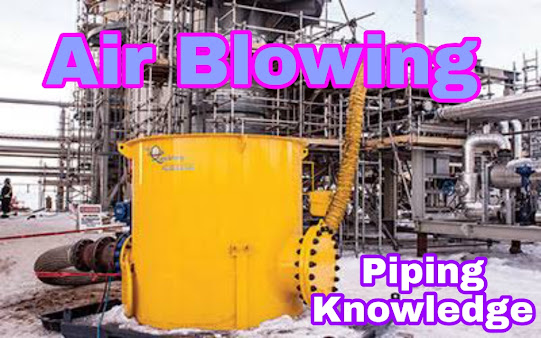Steam Blowing in Piping System.
Steam blowing is a cleaning operation which uses the power and velocity of steam to remove impurities from Equipment parts and additional pipelines, and differences in temperatures during steam blow operation will remove mill scale, due to expansion and contraction of the steam piping.
INDEX:-
1. What is Steam Blowing?
2. Objective of steam Blowing?
3. Method of steam Blowing?
4. Factor to be considered during Engineering phase of Steam Blowing ?
5. Advantage or Disadvantages of discountinuous steam blowing
6. Specific Precaution with Steam Blowing?
1.What is Steam Blowing?
- Steam blowing is a cleaning method where the power and speed of steam in the system (K-factor) are used to remove impurities from Equipment , boiler parts and extra pipelines.
- The temperature differences during steam blowing will remove the mill scale due to expansion and contraction of the steam pipes.
- During a steam blow, the piping is blown with sufficient boiler pressure to ensure that enough dynamic pressure will be experienced in the pipe to provide adequate cleaning.
- The purpose of steam blowing is to dislodge scales and to remove any foreign matter exists in the pipework or vessels and tanks by the application of high drag forcing on the surface of piping.
- The principle behind blowing steam is to clean the lines, i.e. to give it a thermal shock, i.e. heating and cooling with high velocity gas flowing through the line will shock the pipe to break the mill scale and weld slag away from the pipe wall.
2. Objective of steam Blowing?
- The purpose of steam line blowing is to remove pipe slag, weld bead deposits and other foreign material from the main and reheat steam systems prior to turbine operation.
- The following are to be removed from plant critical systems steam piping prior to start-up.
- When pipe fabrication was under progress during hot working days, an oxide layer is formed on the inside surface of pipes. This layer is known as mill scale and this must remove from the system before charging the line with the service.
- Construction Debris
- Scales
- Rust
- Loose material
- Construction leftovers
- Oil
- Weld spatter
3. Method of steam Blowing?
- Steam blowing is one of the initial stages of start-up operation. It uses a high drag force on the surface of your piping to remove and capture debris from your system.
Before steam blowing:
- Complete chemical cleaning of your system to ensure piping is ready for operation
- Complete hydraulic testing of lines
- Ensure all system parts, components and plates are properly set up for steam blowing
Puffing Method Procedure:
- Boiler pressure is slowly raised to the required pressure level and firing rate is increased
- Drum level is brought slightly above normal — when the blowing begins, water level rises beyond sight, as blow proceeds it drops below lowest sight level if water level is maintained at or below normal.
- The first blow is performed at low pressure to check temporary pipe supports and anchors, which must be in place
- Temporary valve opens to blow through superheater, main steam pipe and temporary pipe
- First few steam blows are conducted without target plates until steam color becomes clear
- Then preliminary target or impact plates are placed to capture particles going with the steam
- While blowing, fire is put out and pressure is dropped, ensuring proper temperature differential to dislodge any adhering material
- Steam blowing valve is closed and boiler is started
- Final target plate of turbine blade is placed once preliminary target plate is in acceptable form
- Blowing continues until indentations are acceptable to turbine manufacturer guidelines
- After mainstream line is complete, other stages are done in the similar fashion
Continuous blowing method Procedure:-
- In the continuous blowing method, the process is the same as in the puffing method, except pressure is maintained continuously during the blow to limit sudden forces on temporary piping and reduce stress on the boiler system.
- It puts less stress on your system, but the drawback is that it delivers a slightly lower standard of cleanliness.
- Depending on the sturdiness and cleanliness requirements of your system, either method may be a good fit.
4.Factor to be considered during Engineering phase of Steam Blowing ?
- Disturbance Factor (or) CFR
- Steam blow out method
- Pipe size and Design
- Pipe routing
- Steam conditions
- Noise levels
- Thermal cycling
- Stress analysis for temporary pipework and
- Equipment
- Water quenching
- Because of higher pressure and temperature in this method there is more thermal expansion in the main piping system.
- No gradients to large diameter required from the steam blowing line to silencer.
- No extra process or drinking water injection system required.
- Required K-factor is achived but it is for very short period.
- Load increases greatly due to rapid increase and decrease in pressure and temperature.
- Steam blowing is performed is not as per design parameter of the system.
- Large amount of DM water required compared to countinuous steam blowing.
- Temporary steam blowing system attaracts more cost as it need to be made of alloy steam.
- Temporary blow out valve required which is addition in cost.
- Steam generator need to restart before sucsseding cycles can be started.
6.Specific Precaution with Steam Blowing?
- Are trained and equipped for every project
- Coordinate all efforts with proper plant personnel
- Observe all safety protocols
- Verify and account for all hazards before working with equipment






Comments
Post a Comment